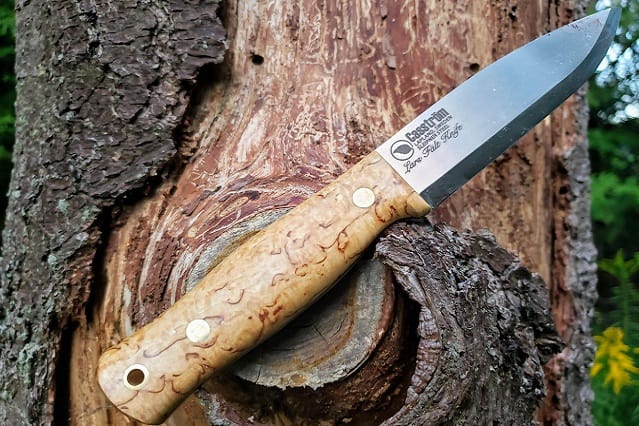(This site is reader-supported. When you buy something using retail links on our articles, we may earn a small commission. As an Amazon Associate I earn from qualifying purchases.)
Sleipner is the most widely used steel for making LionSteel knives. According to the Italian knife brand, Sleipner has a better ability to retain a sharp edge than M390 steel. Well, read on to dive deeper into this knife steel.
What is Sleipner Steel?

Sleipner is a tool steel from the famous European brand, Bohler Uddeholm. The brand has tagged it as a better form of the D2 tool steel.
At a high level of hardness, D2 tends to micro-chip. However, this limitation is no longer with Sleipner, which provides many benefits of a high hardness tool steel while ensuring a stable edge.
Although not made using the Particle Metallurgy (PM) process, Sleipner has a finer steel structure to improve edge retention, polishability, and machinability.
This modern D2 steel is also a proprietary option for making cold work tools. It is recommended for tooling applications that demand resistance to abrasive wear and chipping. Thus, Uddeholm Sleipner is used in blanking and fine blanking, coining, shearing, cold forging, powder pressing, and deep drawing. It is also used to make knives and cutters used to cut other steels.
Chemical Composition
Uddeholm Sleipner is an alloyed tool steel variant featuring chromium, vanadium, and molybdenum. However, the chromium content is not enough to make it stainless. Following are the different elements of this tool steel:
- 0.90% Carbon: For improved hardness as well as resistance to wear and corrosion
- 7.80% Chromium: For improved tensile strength, edge retention, and resistance to corrosion and wear
- 2.50% Molybdenum: For improved strength and machinability
- 0.90% Silicon: For improved strength as well as resistance to corrosion
- 0.50% Manganese: For the improved hardness
- 0.50% Vanadium: For improved resistance to wear and hardenability
Sleipner Steel Hardness
On the Rockwell C scale of hardness, the Sleipner steel has a 58 to 64 HRC rating. However, the exact value depends on the kind of heat treatment used by the maker. This range of hardness is considered very high, especially when the rating goes above 60 HRC. The credit for high hardness goes to the high carbon content along with the presence of vanadium and manganese.
Steel Properties

- Toughness: Do you think this steel will not be tough because it is very hard? After all, higher hardness means lower toughness in the case of steel, right? However, Sleipner is surprisingly tough enough to keep chipping at bay; it is resistant to chipping. After all, it was made as a modern version of the classic D2 tool steel with better toughness to be a better option for knives than D2.
- Good Wear Resistance: It is said that the harder a knife steel is, the better it is at resisting wear. Considering that the hardness level of Sleipner steel is high, it can be concluded that it has a good wear resistance ability. This is attributed to the blend of carbon and molybdenum. This blend also makes this steel strong enough to resist even shock.
- Good Edge Retention: With the maximum hardness of 64 HRC, Sleipner provides good edge retention. It can take and retain a sharp edge quite well for a satisfactory period. However, it would be unwise to expect an edge retention ability like any premium steel.
- Medium Corrosion Resistance: As Sleipner steel is not stainless, you cannot expect it to perform well at resisting corrosion. However, 7.8% of chromium and 0.9% silicon make this steel deliver medium corrosion resistance. Due to low chromium content, it is wise to lubricate your Sleipner blade to keep surface corrosion away. LionSteel offers its Sleipner knives with anti-corrosion coating.
- Ease of Sharpening: It is true that the harder the steel is, the more challenging it becomes to sharpen it. This applies to Sleipner steel knives. Its hardness level can reach up to 64 HRC, and it is not easy to sharpen its blade. Sharpening it will require time and effort.
Comparison With Other Knife Steel Options
Sleipner vs. D2
As mentioned earlier, Sleipner is an upgraded version of D2. Both differ in terms of chemical composition, although they are semi-inox steels.
D2 has more carbon chromium; hence it is harder than Sleipner. This also means that D2 gains an edge in terms of abrasive wear. Nevertheless, this makes it more difficult to sharpen D2. You can gain maximum sharpness with a Sleipner blade due to the steel’s finer grain structure. Sleipner is also tougher than D2. When it comes to edge retention, Sleipner competes closely.
Although corrosion resistance is practically identical, Sleipner is likely to have more resistance to corrosion in humid and seawater environments than D2.
Sleipner Steel vs. A2
Sleipner is more resistant to wear than A2, although the latter is somewhat better in hardness. Sleipner is also tougher than A2, although slightly.
So, is Sleipner Steel Good?
Good resistance to wear, commendable resistance to chipping, and great compressive strength and hardness make this steel ideal for survival, camping, bushcrafting, and EDC knives.
What you need to remember is that Sleipner is not stainless. This means you need to maintain it well by keeping it dry and oiling it frequently to keep rust and corrosion away. In addition, it’s better to consider a Sleipner knife with an anti-corrosion finish.
Also, a Sleipner knife will not ensure edge retention for a very long time. So, be ready to sharpen it often.

Hi, I am Jay. I am the creator of Knife Guides, your one-stop site for everything related to knives. I am a computer engineer by profession, knife aficionado by passion. Here I work with a group of people who’ve always had a passion for knives and blades. Over the years we’ve kind of become experts and decided to share our knowledge and ideas. I am also an avid hiker and enjoy offshore gamefishing.

